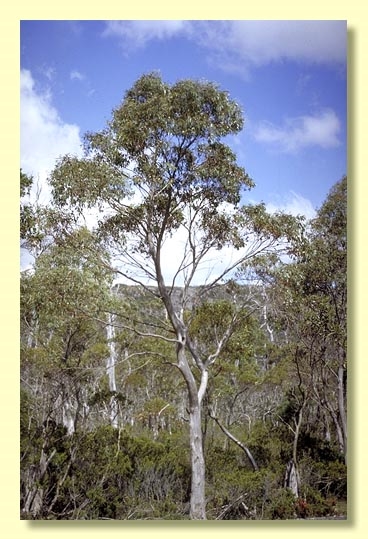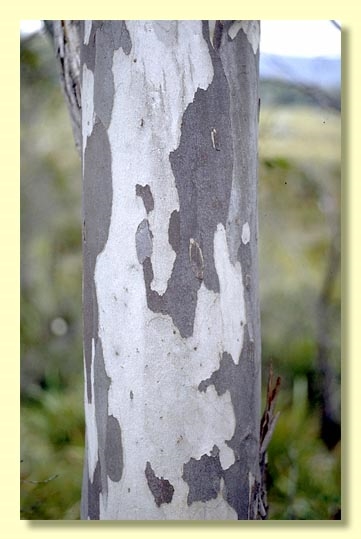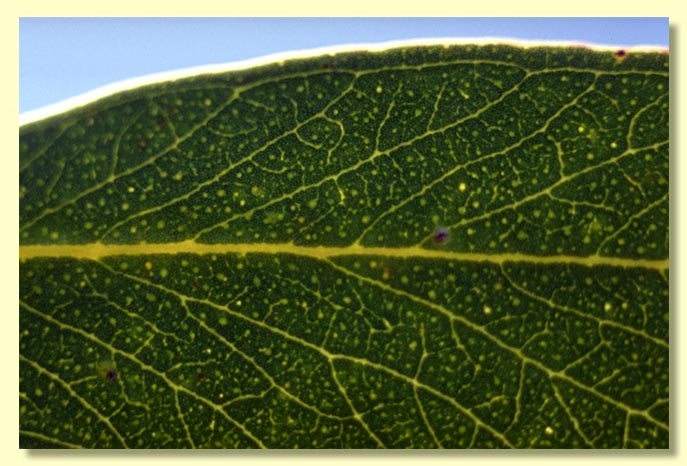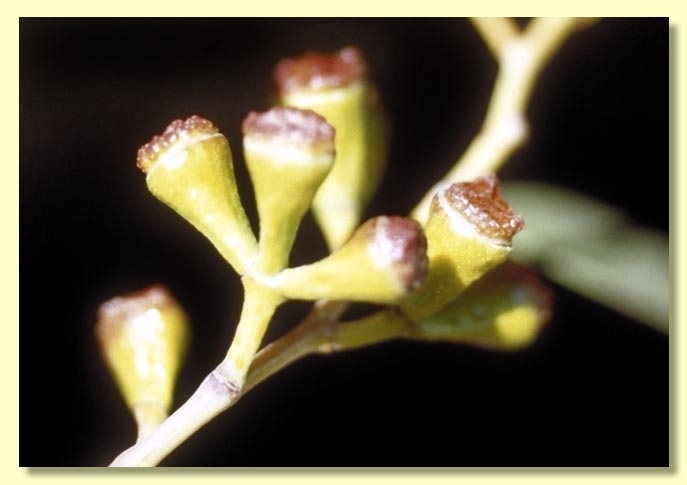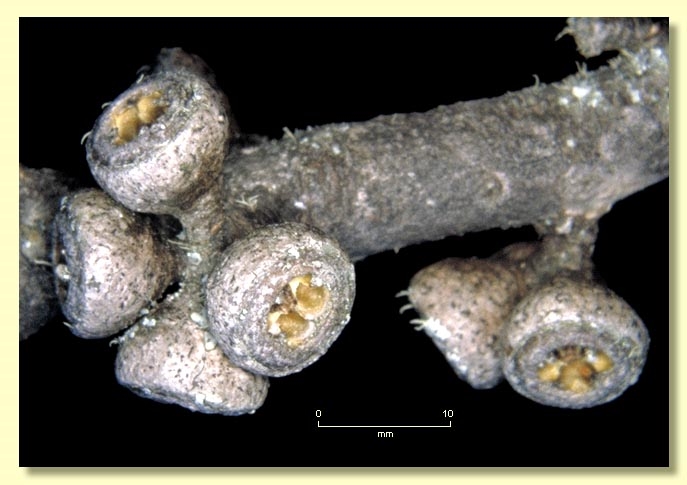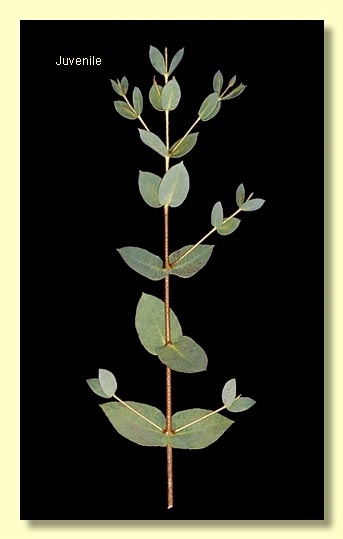Euclid - Online edition
Eucalyptus coccifera
Eucalyptus | Eucalyptus | Aromatica | Insulanae
T: Tasmania. Mt Wellington, R.C. Gunn 1076, 30 October 1840; lectotype: :K000347508; isolectotype: NSW334881; fide Bean, A.R., Telopea 12(4): 514 (2010).
E. daphnoides Miq., Ned. Kruidk. Arch. 4: 133 (1856). T: Van Diemens Land, [Tas.], C.Stuart 9; herbarium of cited specimen unknown to us.
E. coccifera var. parviflora Benth., Fl. Austral. 3: 204 (1867). T: Mt Fatigue, Tas., R.Gunn s.n.; holo: K.
Bark smooth throughout or with a few loose basal grey slabs, smooth bark grey, cream, white, pinkish and fawn, occasionally with horizontal black scars, branchlets often glaucous.
Juvenile growth (coppice or field seedlings to 50 cm): stem rounded in cross-section, often glaucous, warty; juvenile leaves opposite for many pairs, sessile, orbicular to elliptical to ovate or cordate, 1.5–4.5 cm long, 0.7–2.3 cm wide, base tapeing or rounded, margin entire, apex apiculate, green to blue-green.
Adult leaves alternate, petiole 0.8–2.2 cm long; blade elliptical to lanceolate, 5–10 cm long, 1–2 cm wide, base tapering to petiole, concolorous, glossy, green to blue-green, side-veins at an acute or wider angle to midrib, often obscure, reticulation sparse to obscure, intramarginal vein parallel to and well removed from margin, oil glands mostly island or obscure.
Inflorescence axillary unbranched, peduncles 0.4–1.2 cm long, buds 3, 7, or 9 per umbel, pedicels 0.1–0.7 cm long. Mature buds obovoid, 0.5–0.8 cm long, 0.4–0.7 cm wide, glaucous, manifestly warty on operculum, scar absent, operculum flattened to ± rounded, stamens mostly inflexed, anthers reniform to cordate, versatile, dorsifixed, dehiscing by confluent slits, style short, stigma tapered, locules 3 or 4, the placentae each with 2 or sometimes 4 vertical ovule rows. Flowers white to pink (rarely).
Fruit sessile or pedicellate (pedicels to 0.6 cm long), obconical, hemispherical or cup-shaped, 0.6–1.2 cm long, 0.8–1.3 cm wide, sometimes 2-ribbed longitudinally, often glaucous, disc slightly raised-convex to oblique or disc level, valves 3 or 4, near rim level or enclosed.
Seeds brown, 1.5–2 mm long, pyramidal or obliquely pyramidal, dorsal surface smooth to shallowly pitted, hilum terminal.
Cultivated seedlings (measured at ca node 10): cotyledons reniform; stems rounded in cross-section, warty; leaves sessile, opposite for many pairs, elliptical to broadly cordate, 2.5–5 cm long, 1.5–3.8 cm wide, base amplexicaul, margin entire or denticulate, apex rounded to pointed, green or grey-green.
Flowering has been recorded in January, February and December.
A small to medium-sized tree endemic to Tasmania, usually occupying cold upland sites at the altitudinal limits for tree growth, e.g. Mt Wellington and the central plateau.
Eucalyptus coccifera is distinguished by the smooth bark, opposite orbicular to cordate to elliptical juvenile leaves, prominently uncinate and more or less elliptical glossy adult leaves, buds in umbels of threes, sevens or nines, buds with a warty often flat-topped operculum, and glaucous branchlets, buds and fruits. It differs from other three-budded Tasmanian species in having warty buds and lacking an operculum scar. Of the closely related Tasmanian species, all of which have buds in clusters of 7 or more, the smooth-barked E. pulchella differs in having linear adult leaves, whilst E. amygdalina and E. nitida have some rough bark, and both smooth-barked species, E. tenuiramis and E. risdonii, have connate juvenile leaves, which perstist in the latter species into the reproductive crown. In 2008 a 7th Tasmanian peppermint endemic species was described, E. nebulosa, a small smooth-barked tree with grey-blue crown restricted to serpentine ridges north-west of Rosebery; it has narrowly elliptical adult leaves in the crown and sessile short broad elliptical juvenile leaves on coppice growth.
Eucalyptus coccifera belongs to Eucalyptus subgenus Eucalyptus section Aromatica (the peppermints) because the buds have a single operculum, anthers are reniform, seeds are pyramidal and juvenile leaves are sessile and opposite for many pairs. E. coccifera is somewhat anomolous, however, in having ovules in 4 rows unlike virtually all other species in subgenus Eucalyptus, which have ovules in two rows. Within section Aromatica, E. coccifera belongs to an endemic Tasmanian series of 7 species, series Insulanae, with the other 6 species mentioned above, being distinguished from the mainland peppermints, series Radiatae, by having few oil glands in the juvenile leaves.
The only other peppermint species found in Tasmania is the more distantly related, common mainland species, E. radiata subsp. radiata, a rough-barked, tall forest tree with a relict distribution, in Tasmania, in the Lemonthyne area. It has a crown of narrow, green, adult leaves and lanceolate juvenile leaves with numerous oil glands. Other 3-budded species in Tasmania differ from E. coccifera in having buds with an operculum scar (outer operculum shed during bud development).

